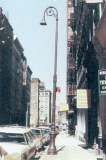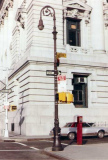Lampposts are where Forgotten NY began, ever since the Department of Transportation replaced nearly every castiron post in Brooklyn and the rest of NYC with streamlined octagonal-shafts and Deskeys between 1950 and 1964 (the process started with a trickle in ’50 and gained steam with new expressway projects in the Swingin’ Sixties). The whole thing inspired me to snap old things before the City gets wise to their presence and takes them away.
I made my first out-of-neighborhood bike ride at age 11 in the summer of 1968, traveling down the Belt Parkway bike path as far as it went to Bay Parkway and then dodging trucks along the Belt Parkway service road. I can’t remember my exact route, but I wound up under West 6th Street, north of Neptune Avenue under the elevatred Culver Line (which by ’68 was the F train, I think) which turned out to be a lamppost graveyard of epic proportions.
Arrayed on the el-shadowed street were scrolled telephone pole still sporting 1930s-1940s-era gumball luminaires; mounted on the el structure were a number of gumballs and Westinghouse cuplights; and there, at the staircase that provided entrance and exit at the Van Siclen station (itself named for a long-closed hotel; since renamed Neptune Avenue station) there was a broken-down “Corvington” longarm that bore enameled street signs denoting West 6th Street and Triton Avenue. The city was just then in the process of eliminating the the street; on its site now there’s a high-rise condo building. Amazingly there are still some enamel Triton Avenue and Shell Road signs (seen on FNY’s Tough Shell page) on what used to be the other end of the short street.
If I could ever get my hands on an H.G. Wells-model time machine I wouldn’t take it to 802,701 AD and battle Morlocks. I’d take it to the late 60s and go to West 6th and Triton Avenue and get photos of all the treasures I saw that day.
I don’t know if ForgottenFan Bob Mulero ever made it to the Street that the DOT Forgot, but he shot quite a number of outmoded NYC poles when they were still standing beginning in the mid-1970s. Many of the ones he did in today’s sampler are still there…believe it… or not, as Jack Palance used to say. All photos on this page by Bob, with my thoughts appended.
When the Gowanus Expressway was rammed through Bay Ridge from 1959-1964, these special highway posts went up by the thousands. Superficially they resembled the new octagonal poles that were going up on the regular street grid, but these had a cylindrical shaft instead of the octagonal shape preferred on the street-side poles. I don’t know why the DOT preferred cylindrical for highways, but in the 1980s, cylindrical became the preferred shape and thousands of those were erected. Later, the DOT reversed course and capriciously went back to octagonal.
Most of the posts on the Gowanus carried GE M400s, as sen above on this present-day survivor on 7th Avenue, the Gowanus’ service road in Bay Ridge. (Seeing a rival Westinghouse Silverliner OV25 was a rarity there.) Toward the bridge, and then spanning the Verrazano, the roadway swicthed to a special model that resembled a cut-off Silverliner. I’ve never seen them anywhere else, and now most if not all of those are gone.
LEFT: This Type 24A-W bishop crook on Walker Street west of Broadway in Tribeca is still there, but with a pendant sodium “bucket.” RIGHT: This 24M Bishop at State and Bridge Streets also remains, but its 1960s yellow-black street signs have been replaced by black and white Downtown Alliance numbers. The Bell lume became a bucket lamp. Though this post had Landmarks protection, down it came in 2009.

At any rate these posts, with the picturesque footrests for workmen to climb on when it’s time to change the bulb, go back pretty far in the bridge’s history. Sometime in the 1930s or 40s, they were outfitted with gumball luminaires.
When the bridge was renovated in the 1980s, the posts were replaced by replicas that looked almost exactly the same, except for a fancier base. The new lamps are metal halide bright white.
The curved-arm masts supporting the GE M400s formerly had carried gumballs as well. The masts are still there, supporting a few different sodium luminaires.
By the Tunnel
Streets surrounding the Manhattan end of the Brooklyn-Battery Tunnel, Greenwich, Morris, and Washington, boast a number of Type 24M Corvington posts that somehow have survived waves of lamppost purges. They now have either modern sodium luminaires or new Mission Bell lamps. Bob snapped them around 1978, when they still had older Bells and Westy cups.
LEFT: Greenwich Street near Morris; RIGHT: Morris Street west of Washington Street
LEFT: Washington Street at Morris, boasting 1960s yellow and black street signs. The 1940s-era tunnel roadway posts are also still there. This post likely predates both the tunnel and parking garage; Washington Street ran continuously north of here until the tunnel construction began in the 1940s, and Morris continued east to Broadway. RIGHT: Both these Corvs, at the triangle formed by Greenwich and Morris Strets and Trinity Place, are still there.
LEFT: I’m unsure of where this batterred Corv was, but it probably didn’t last too long after the photo was snapped. RIGHT: Early 1970s at the Manhattan entrance of the Manhattan Bridge. Until the late 1990s it was a graveyard of old NYC lamps, with a number of strangely-painted Type 24M Corvs (above), reverse-scrolled Type Fs, and curved-mast octagonal posts.
Voice of the Turtle. Not sure what manufacturer made these…they were vastly outnumbered on NYC side streets by GE scoops and Westinghouse wedges. But the turtlebeaks, as I call them, had their moments. This one was on Grace Court Alley in Brooklyn Heights.
2/14/08




